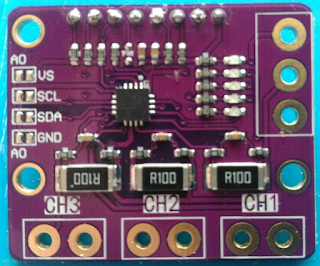DSO 150: Timebase
The voltage management was designed by Jyetech to reflect the values they wanted to use.
The resistors have the right values to form good voltage dividers, and as a result, converting between them and volt/div is pretty simple.
It's not so simple for the timebase.
Ideally, we'd like standard value, such as 10us/div, 50ms/div etc...
Since we use 24 pixels per div, that would mean 10us/24, 50ms/24 etc... sampling frequency
Unfortunately, we don't have the required flexibility as far as sampling frequencies are concerned.
Here is a table of all the available values (prescaler x sampling time)
Multiple by 24, to get the time/div
Not so great in terms of user experience, 45.33 us/div is not very user friendly.
So, what we'll do is oversample a bit the value we actually aim at, and then decimate it.
It is a very simple decimate so that it does not slow down everything too much.
For example, if we want 100 samples at 500us/div, we'll program 400us/div, take 125 samples and decimate them regularly to keep only 100 values.
The table to deal with that is now:
Where expand is the discard/expansion ratio.
If we want 100 samples, we need to acquire 100*Expand, and decimate accordingly.
We might do a real resampling later if it is fast enough
When selecting the candidates for the AcqTime/Prescaler pair, we'll take the highest Acq time to favor accuracy.
So now, we have 'fast sampling' working for both time & voltage.
Need to do 'slow sampling' & triggering, and we have something remotely usable.
The resistors have the right values to form good voltage dividers, and as a result, converting between them and volt/div is pretty simple.
It's not so simple for the timebase.
Ideally, we'd like standard value, such as 10us/div, 50ms/div etc...
Since we use 24 pixels per div, that would mean 10us/24, 50ms/24 etc... sampling frequency
Unfortunately, we don't have the required flexibility as far as sampling frequencies are concerned.
Here is a table of all the available values (prescaler x sampling time)
| 2 | 4 | 6 | 8 | |
| 1,5 | 0,39 | 0,78 | 1,17 | 1,56 |
| 7,5 | 0,56 | 1,11 | 1,67 | 2,22 |
| 13,5 | 0,72 | 1,44 | 2,17 | 2,89 |
| 28,5 | 1,14 | 2,28 | 3,42 | 4,56 |
| 41,5 | 1,50 | 3,00 | 4,50 | 6,00 |
| 55,5 | 1,89 | 3,78 | 5,67 | 7,56 |
| 71,5 | 2,33 | 4,67 | 7,00 | 9,33 |
| 239,5 | 7,00 | 14,00 | 21,00 | 28,00 |
| Time/sample (us) | ||||
Multiple by 24, to get the time/div
Not so great in terms of user experience, 45.33 us/div is not very user friendly.
So, what we'll do is oversample a bit the value we actually aim at, and then decimate it.
It is a very simple decimate so that it does not slow down everything too much.
For example, if we want 100 samples at 500us/div, we'll program 400us/div, take 125 samples and decimate them regularly to keep only 100 values.
The table to deal with that is now:
| Time/div (us) | ADC | Prescaler | AcqTime | Expand | Expand *4096 | |
| 25 | 17,33 | 2 | 13,5 | 1,44 | 5909 | |
| 50 | 45,55 | 2 | 55,5 | 1,10 | 4496 | |
| 100 | 90,67 | 4 | 55,5 | 1,10 | 4517 | |
| 500 | 336 | 4 | 239,5 | 1,49 | 6095 | |
| 1000 | 672 | 8 | 239,5 | 1,49 | 6095 | |
Where expand is the discard/expansion ratio.
If we want 100 samples, we need to acquire 100*Expand, and decimate accordingly.
We might do a real resampling later if it is fast enough
When selecting the candidates for the AcqTime/Prescaler pair, we'll take the highest Acq time to favor accuracy.
So now, we have 'fast sampling' working for both time & voltage.
Need to do 'slow sampling' & triggering, and we have something remotely usable.



Comments
Post a Comment